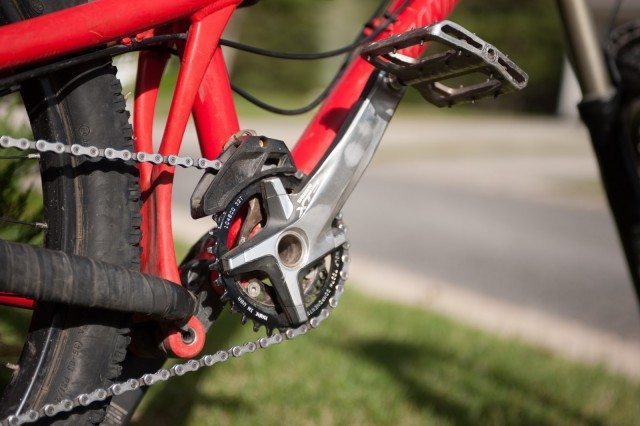
Wolf Tooth Components 104 BCD 32T Chainring
Intended Use: XC Race, Trail, AM
Size Tested: 32 Tooth
MSRP (32 tooth): $68
Test Locations: Park City, UT
Days Ridden: 40 Days
Tester Info: 5’8″, 160 lbs.
In fall 2012, SRAM released the XX1 drivetrain with eleven cogs and only one chainring. They used a unique chainring design—tall, alternating-width teeth with a thick rib on each side of the wide teeth—that would hold the chain without a front derailleur or chainguide.
Many riders have used 1×9 and 1×10 setups for years with chainguides to keep the chain on the front chainring. These systems allow for simple, sequential gear changes (no cross-over shifting to get the next harder or easier gear), and they have great chain retention. But if you want to cut down on weight, complexity, cost, and noise, it makes sense to run a naked chainring without a guide.
The SRAM XX1 chainring works with 10-speed drivetrains, but it uses a unique bolt pattern that only appears on the XX1 cranks. Riders who wanted to use one of these chainrings on Shimano, Hive, FSA, Raceface, or other cranksets were out of luck—at least until recently.
Narrow / Wide Chainring
Enter Wolf Tooth Components, a company based out of Minneapolis, Minnesota. They were one of the first aftermarket manufacturers to release what’s now known as a narrow/wide chainring.
And before we go any farther, it’s important to note that any narrow/wide chainring is designed to be paired with a Plus (Shimano) or Type 2 (SRAM) derailleur. These derailleurs resist counter-clockwise rotation of the cage, thus limiting variation in chain tension over rough terrain.
It’s possible to use a narrow/wide chainring with a different derailleur, but you might be disappointed by the results. Clutch derailleurs like the Plus and the Type 2 minimize chain slap by keeping the chain stable on a chainring. With less chain slap, the narrow/wide chainring can keep a chain on the ring—without a guide. Take away the clutch derailleur, however, and the chain slap might be enough to drop the chain.

The Patent
Wolf Tooth’s chainring is based on a design patented back in the ‘70s and originally intended for agriculture use. While it hasn’t seen much use on mountain bikes until now, it’s the reason why Wolf Tooth and other companies can design a chainring that looks very similar to the SRAM XX1 component.
Several other manufacturers are also making chainrings designed to improve chain retention. Race Face just released a chainring with alternating width teeth and a cross-shaped cross-section, but it doesn’t have the tall teeth of the XX1 and Wolftooth chainrings. These taller teeth are not part of the original patent, but they make it harder for the chain to come off the chainring.
Absolute Black offers a similar chainring, but it also has hooked teeth. FSA is testing yet another design, but they haven’t released many details yet.
The Build
Wolf Tooth chainrings are machined from 7075-T651 aluminum and anodized black. The narrow/wide tooth pattern meshes tightly with my 10-speed Shimano XT chain. According to Wolf Tooth, the chainring will work with all 9-, 10-, and 11-speed chains.
The Ride
My previous setup was an E-13 Guidering and an LG1+ guide with a Shimano Shadow Plus derailleur. I never lost a chain with that setup, but it did make noise and it added drag when the chain was at the cassette’s extremes.
I ran the Wolf Tooth chainring in two different arrangements. First, I ran it with the top guide cage from the E-13 LG1+. Taking off the lower pulley from the E-13 guide quieted my bike when pedaling and reduced the drag in my drivetrain by a noticeable amount.

But the upper guide was still noisy when I was riding over rocky sections of trail. So for the second setup, I removed the upper guide. To my surprise, the chain didn’t fall off and the drivetrain was quieter. With no cage or other surfaces for the chain to bounce against at the front chainring, my bike was much quieter than it had been with the full LG1+ guide and E-13 Guidering on it.
I sought out rough, rocky terrain to challenge the holding power of the narrow/wide teeth and was impressed by the chainring’s ability to keep the chain on. I have been riding with this setup for almost two months, and lost the chain for the first time just a week ago.
This prompted me to check my chain for stretch and, sure enough, it was about time to replace the chain. Since removing the upper guide, I’ve stuck with the bare ring and haven’t seen a reason yet to replace the guide.
And remember: With any of these narrow/wide chainrings, you’ll need to monitor chain stretch closely (something you should be doing anyway), to prevent the chain from dropping.
Gear Range
Perhaps the most common concern with using a single chainring is the limited gear range. While most people don’t worry about the loss of harder gears, they’re usually reluctant to give up their granny ring.
For those granny-gear champions out there, take heart. Wolf Tooth offer a clever 30t chainring that manages to get around the 104mm BCD that gets in the way of such a small chainring.

Previously (and with XX1), riders needed to get rid of the standard spider to use a chainring smaller than 32 teeth. Wolf Tooth gets around this by machining spacers onto the chainring that offset it 2mm toward the centerline of the frame. This allows the outer plates of the chain to sit between the chainring and the spider of the crank.
Without the offset, there would be interference between the chain and the spider. The ring alters chainline slightly, but this can be accommodated by moving a bottom bracket spacer. Running a 30t chainring with an 11-36 cassette provides a low enough gear ratio for most riders.
Bottom Line
The Wolf Tooth chainring is expensive ($68 for the 32-tooth version and up to $76 for the 38-tooth ring), for a chainring, but it’s relatively inexpensive if it means you don’t need a chainguide.
If you currently use a single front ring on a trail bike, I’d recommend replacing it with a narrow-wide chainring. It is simpler, quieter, and lighter.
If you’re running two or three chainrings, I’d suggest limiting the gears you use on a ride as an experiment to see if you really need the broader range. Cassette ranges have grown since bikes were first sold with three chainrings, and you might find yourself surprised by how few gears you really need.
So if you’re an avid, fit rider, I would strongly recommend trying out the Wolf Tooth chainring. At worst, it’s an interesting experiment. At best, it will make your bike lighter, simpler, and quieter.
